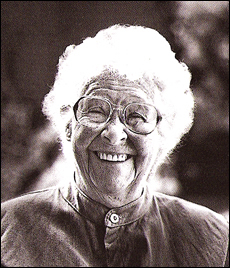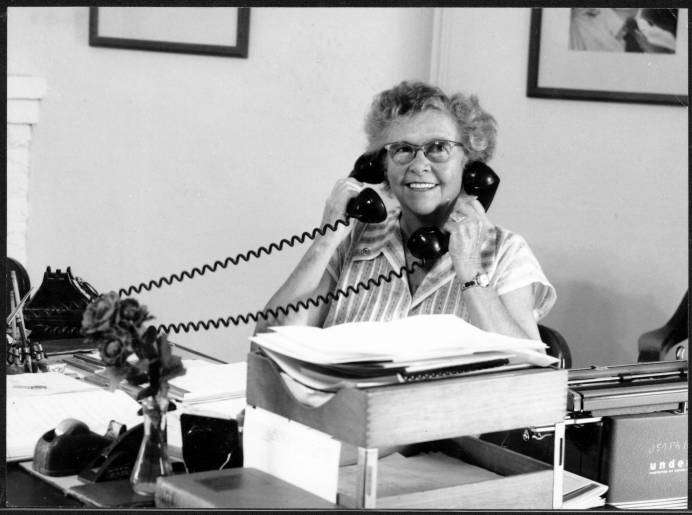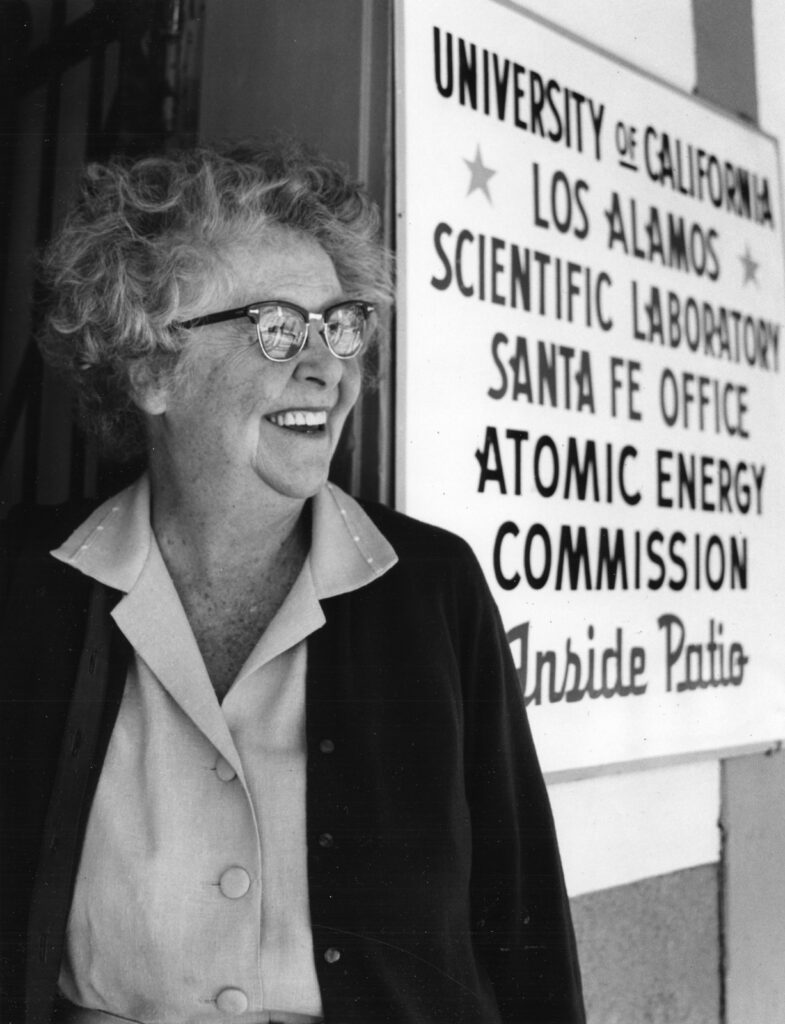Dorothy McKibbin, “Gatekeeper of Los Alamos” at work.
Dorothy McKibbin, “Gatekeeper of Los Alamos”
1897 - 1985
Santa Fe County
Her office was the entrance and departure point for scientists, military personnel, Project employees, and their families who worked and lived at the top-secret Manhattan Project headquarters in Los Alamos. As the head of the Santa Fe office, she played an indispensable role during the war and until her retirement in 1963.
Dorothy McKibbin was the first person to greet newly arriving scientists, workers, and their families on their way to “The Hill,” the top-secret headquarters for the Manhattan Project in Los Alamos. Hired by Robert Oppenheimer as a secretary in 1943, her office at 109 East Palace Avenue in Santa Fe was the entrance and departure point for scientists, military personnel, Project employees, and their families who worked and lived at Los Alamos.
McKibbin operated a welcoming central office by providing assistance, directions, reservations, or just a kind word. She played an indispensable role during the war, and afterward remained the head of the Santa Fe office until she retired in 1963. Remembered for her warmth and generous spirit, Dorothy McKibbin was aptly nicknamed the “Gatekeeper of Los Alamos.” Among the women most associated with the Manhattan Project, her influence on those who worked on “The Hill” was significant.
Missouri-born McKibbin first came to New Mexico in 1926 as a tuberculosis patient seeking treatment at Sunmount Sanatorium in Santa Fe. She returned in 1931, after her husband’s death, to bring her young son up in Santa.
In 1943, at a meeting with Robert Oppenheimer in the lobby of La Fonda Hotel in Santa Fe, she was immediately impressed with his demeanor. “I thought that anything with which a man of that magnetism was connected was what I would enjoy,” she later recalled. She declined an offer to work at a local bank and instead agreed to accept a position working on what was then known as “Project Y.”
From her office just down the street from La Fonda, at 109 East Palace Avenue, McKibbin greeted new employees as they arrived in Santa Fe to work in Los Alamos. Many arrived bewildered, with their families in tow, most not sure what the project was about. She became known as the “Gatekeeper of Los Alamos” for her warm personality, as recalled by Manhattan Project scientist Rebecca Diven in an interview: “Dorothy was wonderful. She would get whatever you needed and send it up. You could walk in on Dorothy at her office at 109 E. Palace Avenue and even if she were busy, she would stop what she was doing and pay complete attention to you. You felt as if you were the most important person in the world to Dorothy. She was a really warm person.”
The top-secret Manhattan Project, centered in the new city of Los Alamos between the years 1942 and 1946, culminated in the development of the world’s first atomic bomb. The Project employed more than 130,000 individuals, including a number of prominent well-known people including Major General Leslie R. Groves, Jr., Robert Oppenheimer, and Enrico Fermi.
On August 6, 1945, the United States dropped the world’s first atomic bomb over Hiroshima, Japan, ending World War II and forever changing the history of Los Alamos and the men and women who worked there. Women played key roles in the top secret Manhattan Project, both as employees of the Project and also in the budding community of Los Alamos. As scientists, engineers, intelligence officers, and clerks, these women notably served in scientific and administrative capacities and performed duties of technical and sensitive nature related to the Project, in job titles as wide ranging as file clerk, intelligence security officer, lab technician, physical chemist, procurement, electronics technician, engineering draftsman, pass and badge office worker, mailroom worker, typist in post office, housekeeper, and telephone operator. In addition, women held traditional roles as wives and mothers, and also worked in the community as school teachers, waitresses, and nurses. Members of the Women’s Army Auxiliary Corps (WAACs) also provided much needed scientific and administrative support: Processing of mail and records provided such a broad view of Project activities that it was kept in the hands of personnel under strict military control. WAACs were brought in as handlers of classified material and a great variety of other jobs, some of them highly technical and scientific.
Like their male counterparts, many women did not know the purpose of their work until the infamous day the bomb was dropped. Some of the scientists’ wives, particularly those with a technical background, understood what the work was leading to, some laboratory workers knew details, some pieced together a vague understanding of the significance of the Project, and some were completely unaware.
Historian Kathleen E. B. Manley writes about the work ethic of these women:
“…most of them were extremely busy. Those women who worked in the laboratory full time worked six days a week, with one shopping day off every month. In letters written to her family in 1944 and 1945, Beckie Bradford Diven commented on the long hours. Rose Pingel Watts pointed out that the general attitude was to keep working if someone needed something. The women who came to Los Alamos as part of the Women’s Army Corps (WACs) worked six days a week, like the rest of the laboratory workers. Elsie Pierce, however, who was a motor transport driver, said the army was on duty twenty-four hours a day. She recalled that people didn’t worry about days off; everyone was there for a purpose and worked as long as he or she was needed.”
In September of 1984, McKibbin was honored as a “Santa Fe Living Treasure.” The organization wrote: “As scientists from all over the free world poured into New Mexico in 1943 to work on the Manhattan Project, each and every one of them passed through the office, at 109 Palace Avenue, of Dorothy McKibbin. Traveling under assumed names, weary, bewildered, often with no idea where they were headed, they were grateful for her welcome and the yellow map, and the reassuring words, ‘Only thirty-five miles to go.’ With an exquisite combination of tact, intelligence, loyalty, hospitality, humor and motherly warmth, she served as ‘gatekeeper to Los Alamos.’ Throughout her life she maintained many close friendships with those she helped orient ‘to the Hill.’ More than twenty Los Alamos couples were married in her house on Old Santa Fe Trail.”
Sources:
Bibliography
“Manhattan Project Spotlight: Dorothy McKibbin.”
http://www.atomicheritage.org/article/manhattan-project-spotlight-dorothy-
Mckibbin, accessed November 29, 2016.
“Dorothy McKibbin Oral History.” http://manhattanprojectvoices.org/oral-histories/dorothy-mckibbins-interview-1965, accessed November 29, 2016.
“Haskell Sheinberg Oral History.”
http://www.manhattanprojectvoices.org/oral-histories/haskell-sheinbergs-interview, accessed November 29, 2016.
“Rebecca Bradford Diven Oral History.”
http://www.manhattanprojectvoices.org/oral-histories/rebecca-bradford-divens-interview, accessed November 29, 2016.
Jones, Vincent C. Manhattan: The Army and the Atomic Bomb. Washington, DC: Center of Military History, United States Army, 1985.
Manley, Kathleen E. B. “Women of Los Alamos During World War II: Some of Their Views.” New Mexico Historical Review, Volume 65, Number 2, April 1990.
Melnick, A. J. (sic). They Changed the World: People of the Manhattan Project. Santa Fe: Sunstone Press, 2006.
National Park Service. “Otowi Historic District.” National Register of Historic Places Inventory—Nomination Form. July 15, 1975.
“Dorothy McKibbin, ‘Gatekeeper’ of Los Alamos, Honored
September 1984.” http://www.sflivingtreasures.org, accessed November 29, 2016.
Wilson, Jane S. and Charlotte Serber, eds. Standing By and Making Do: Women of Wartime Los Alamos. Los Alamos, NM: Los Alamos Historical Society, 1988. Text Approved by CPRC on Date: October 13, 2017.
Learn more about Dorothy McKibbin, “Gatekeeper of Los Alamos” and our resources for educators on the New Mexico Historic Women Marker Program curriculum page.









